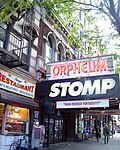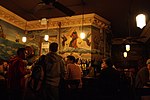St. Mark's Playhouse
East Village, ManhattanManhattan building and structure stubsOff-Off-BroadwaySecond Avenue (Manhattan)United States theater (structure) stubs
St. Mark's Playhouse at 133 Second Avenue in the East Village of Manhattan, New York City, was an Off-Off-Broadway theater notable for presenting the Negro Ensemble Company's production of The First Breeze of Summer by Leslie Lee, which premiered on March 2, 1975, before transferring to Broadway on June 10, where it played through July 20, 1975. St. Mark's Playhouse also showed French playwright Jean Genet's first American performance of his play The Blacks. The theatre was founded by Lynn Michaels and Harry Baum.
Excerpt from the Wikipedia article St. Mark's Playhouse (License: CC BY-SA 3.0, Authors).St. Mark's Playhouse
2nd Avenue, New York Manhattan
Geographical coordinates (GPS) Address Website Nearby Places Show on map
Geographical coordinates (GPS)
| Latitude | Longitude |
|---|---|
| N 40.728888888889 ° | E -73.987777777778 ° |
Address
Ottendorfer Library
2nd Avenue 135
10003 New York, Manhattan
New York, United States
Open on Google Maps








